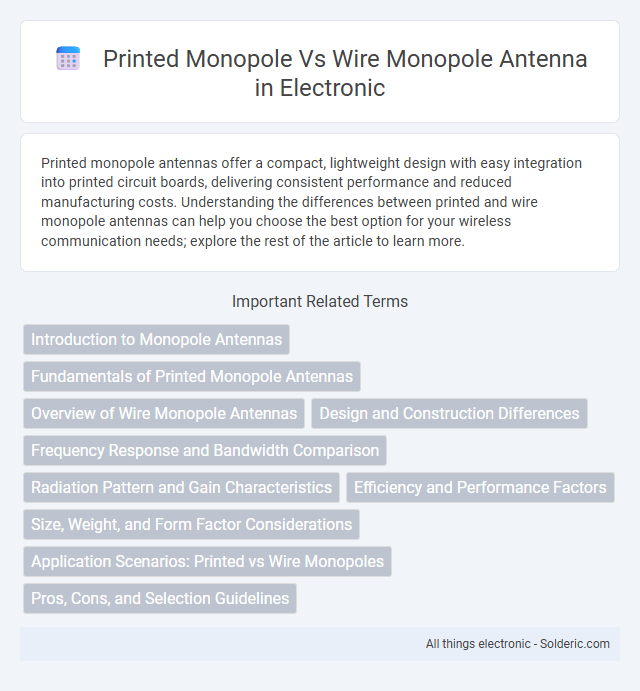Printed monopole antennas offer a compact, lightweight design with easy integration into printed circuit boards, delivering consistent performance and reduced manufacturing costs. Understanding the differences between printed and wire monopole antennas can help you choose the best option for your wireless communication needs; explore the rest of the article to learn more.
Comparison Table
| Feature | Printed Monopole Antenna | Wire Monopole Antenna |
|---|---|---|
| Structure | Planar, printed on PCB substrate | Single vertical wire or rod |
| Size | Compact, integrates with PCB | Typically longer, bulkier |
| Fabrication | PCB manufacturing process | Mechanical wiring or metal rods |
| Bandwidth | Moderate, can be optimized via design | Narrower bandwidth generally |
| Impedance | Customizable via layout and substrate | Standard 50 ohms matches typical feed lines |
| Durability | High, protected by PCB materials | Vulnerable to bending and corrosion |
| Cost | Low to moderate, mass production friendly | Low, simpler materials |
| Applications | Compact wireless devices, IoT, RFID | Base stations, measurement antennas |
Introduction to Monopole Antennas
Monopole antennas consist of a single radiating element mounted perpendicularly above a conductive ground plane, enabling efficient radiation with a compact design. Printed monopole antennas are fabricated using conductive materials on dielectric substrates, allowing for low-profile, lightweight, and easily integrable structures in modern communication devices. Wire monopole antennas, typically made from metal rods or wires, offer simplicity and robustness but are bulkier and less adaptable to miniaturized or planar applications.
Fundamentals of Printed Monopole Antennas
Printed monopole antennas utilize a flat conductive patch on a dielectric substrate, offering compactness and ease of integration in modern wireless devices. Their fundamental design relies on the quarter-wavelength resonance principle, similar to wire monopoles, but benefits from planar fabrication techniques that enhance bandwidth and radiation efficiency. Your selection of a printed monopole antenna ensures improved impedance matching and reduced size compared to traditional wire monopole antennas, ideal for compact communication systems.
Overview of Wire Monopole Antennas
Wire monopole antennas consist of a single, straight conductor mounted perpendicular to a conductive ground plane, typically a quarter-wavelength long for optimal resonance. These antennas are favored for their simplicity, omnidirectional radiation pattern, and efficient signal transmission in VHF and UHF frequency bands. Your choice between wire and printed monopole antennas may depend on factors like installation convenience, size constraints, and desired frequency range.
Design and Construction Differences
Printed monopole antennas are fabricated using photolithography on dielectric substrates, enabling compact, low-profile designs with precise geometric control and consistent performance. Wire monopole antennas consist of metallic rods or wires mounted perpendicularly to the ground plane, offering simpler construction but larger physical size and less integration flexibility. Printed designs support multilayer PCB integration and are ideal for modern, miniaturized wireless devices, whereas wire monopoles are favored for traditional applications requiring robust, straightforward antenna elements.
Frequency Response and Bandwidth Comparison
Printed monopole antennas typically exhibit wider bandwidth and more consistent frequency response due to their planar structure and precise fabrication on dielectric substrates. Wire monopole antennas often have narrower bandwidths with resonant frequency sensitivity to physical length and environmental factors. Your choice depends on the need for compact size and broad frequency coverage versus simplicity and ease of tuning.
Radiation Pattern and Gain Characteristics
Printed monopole antennas typically exhibit a broader radiation pattern with nearly omnidirectional coverage, making them ideal for applications requiring wide-angle signal reception. Wire monopole antennas provide higher gain in the horizontal plane due to their longer effective radiating element, resulting in more focused energy and improved range in specific directions. Your choice depends on whether you prioritize uniform coverage or enhanced directional gain for optimized wireless communication.
Efficiency and Performance Factors
Printed monopole antennas offer compact size and ease of integration on circuit boards but often face lower efficiency due to substrate losses and limited ground plane size. Wire monopole antennas typically exhibit higher radiation efficiency and better omnidirectional performance because of their simpler structure and larger effective ground plane. You should consider the application's size constraints and performance requirements when choosing between these antenna types.
Size, Weight, and Form Factor Considerations
Printed monopole antennas offer a compact form factor and lightweight design ideal for modern devices with stringent space constraints, leveraging PCB integration to reduce size significantly. Wire monopole antennas, while typically larger and heavier due to the use of metal wires or rods, provide greater flexibility in tuning and often better performance at lower frequencies. Your choice depends on the balance between minimizing size and weight for portability versus maximizing antenna efficiency and frequency range.
Application Scenarios: Printed vs Wire Monopoles
Printed monopole antennas are widely used in compact wireless devices such as smartphones, tablets, and IoT gadgets due to their low profile, ease of integration with PCB, and cost-effective mass production. Wire monopole antennas find application in outdoor and vehicular communication systems where durability, higher gain, and longer range are critical, such as in base stations, marine radios, and emergency communication setups. Your choice depends on whether you prioritize compact design and integration (printed monopole) or robustness and extended coverage (wire monopole).
Pros, Cons, and Selection Guidelines
Printed monopole antennas offer compact size, ease of integration with PCB technology, and cost-effective mass production, making them ideal for modern wireless devices; however, they may suffer from limited bandwidth and reduced radiation efficiency compared to wire monopoles. Wire monopole antennas provide superior radiation efficiency, wider bandwidth, and better gain performance but are bulkier, less convenient for compact device integration, and more susceptible to mechanical damage. Select printed monopoles for space-constrained and low-cost applications requiring moderate performance, while wire monopoles suit scenarios demanding higher performance, greater range, and robust mechanical durability.
printed monopole vs wire monopole antenna Infographic

 solderic.com
solderic.com